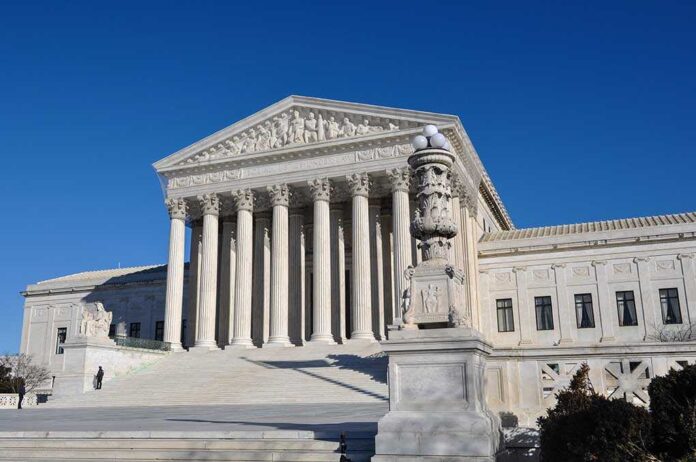
The Supreme Court’s decision to allow President Trump to fire a Biden-appointed FTC commissioner without cause has sent shockwaves through Washington, signaling a potential dismantling of longstanding constraints on presidential authority and a direct challenge to the independence of federal agencies.
Story Highlights
- Supreme Court permits President Trump to remove FTC Commissioner Rebecca Slaughter, overturning earlier court orders.
- Decision signals the Court’s willingness to reconsider the 90-year-old Humphrey’s Executor precedent limiting presidential removal power.
- Ruling could strengthen executive authority over independent agencies, aligning agency leadership more closely with administration priorities.
- Potential for sweeping changes in the structure and independence of federal regulatory bodies, impacting constitutional checks and balances.
Supreme Court Greenlights Trump’s Unprecedented Removal of FTC Commissioner
On September 22, 2025, the Supreme Court granted the Trump administration’s application for a stay, effectively allowing the removal of FTC Commissioner Rebecca Slaughter to stand while litigation continues. This action reversed a lower court’s injunction that had ordered Slaughter’s reinstatement and prohibited further interference, directly challenging the statutory protections that have historically guarded the independence of the Federal Trade Commission. Trump removed both Slaughter and fellow commissioner Alvaro Bedoya in July, citing “inconsistency with Administration’s priorities.”
This move not only overturned a district court’s ruling but also overrode the D.C. Circuit’s denial of a stay, which had relied on the Supreme Court’s own 1935 Humphrey’s Executor decision. By stepping in, the Supreme Court has signaled its openness to revisiting this longstanding precedent, which limits the president’s ability to remove independent agency officials without cause. The Court’s order included no detailed opinion, but its willingness to grant the stay is seen as a strong indication of a potential shift in the legal landscape.
Presidential Authority Versus Agency Independence
The underlying legal battle centers on a critical constitutional question: Should the president have sweeping authority to remove officials from independent agencies, or should such agencies maintain protections to ensure they remain insulated from political interference? The Federal Trade Commission Act of 1914, as interpreted by Humphrey’s Executor v. United States, restricts the president’s power to remove commissioners except for cause such as inefficiency or malfeasance. However, recent Supreme Court decisions—such as Seila Law LLC v. CFPB (2020) and Collins v. Yellen (2021)—have begun to erode these protections for other agencies, setting the stage for the current challenge.
President Trump and his administration argue that the Constitution vests executive power solely in the president, and that the ability to remove non-cooperative officials is essential for accountability and effective governance. Critics of this view warn that granting the president unchecked removal authority would destroy the independence of agencies tasked with enforcing antitrust and consumer protection laws, opening the door to politicized enforcement and eroding vital checks and balances in government.
Implications for the Future of Federal Agencies
The immediate effect of the Supreme Court’s decision is the removal of Biden-appointed officials who did not align with the current administration’s policies. But the long-term stakes are far greater: If the Court ultimately overturns or narrows Humphrey’s Executor, future presidents could gain broad authority to fire independent agency officials at will. This would fundamentally reshape the structure, independence, and role of federal regulatory bodies, potentially increasing politicization and reducing the stability and expertise within agencies.
Such a shift would resonate far beyond the FTC, potentially affecting all independent agencies and the industries they regulate. Proponents of strong executive power see this as a restoration of constitutional order and democratic accountability, while defenders of agency independence fear a loss of institutional safeguards designed to protect the public interest from political swings and overreach. The debate strikes at the heart of the separation of powers and the very framework of American government.
Next Steps: Landmark Decision on the Horizon
With the Supreme Court now set to review the full case, all eyes are on whether the justices will overturn a precedent that has shaped the federal government for nearly a century. The outcome will determine not only the fate of the FTC’s current leadership but also the future balance of power between the executive branch and independent regulators. For conservatives concerned about runaway bureaucracy and unelected officials obstructing constitutional governance, this moment offers a potential return to accountability and limited government. For others, it raises alarms about the erosion of agency expertise and the politicization of regulatory enforcement. The case is poised to become a defining battle over the limits of presidential power and the preservation of constitutional values.
Sources:
U.S. Court of Appeals for the D.C. Circuit, No. 25-5261, September Term, 2025
Supreme Court of the United States, 25A264 Trump v. Slaughter (09/22/2025)












